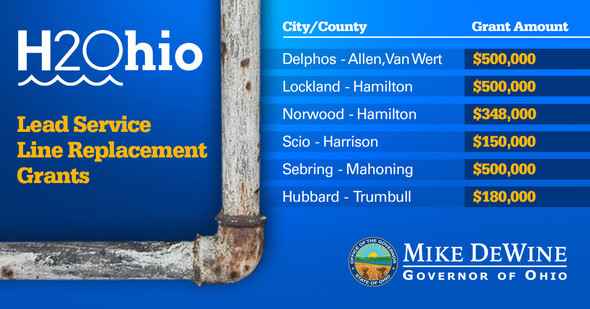(COLUMBUS, Ohio)— As part of his comprehensive strategy to address lead hazards and prevent lead poisoning in Ohio, Governor Mike DeWine announced today that his H2Ohio initiative is investing $4 million to locate, remove, and replace toxic lead pipes in various communities throughout the state.
“We want all of our residents, no matter where they live, to be confident that their drinking water is clean and not contaminated by decomposing lead pipes that should have long ago been replaced,” said Governor DeWine. “My focus every day is on the health and safety of all of our citizens, and I won’t be satisfied until lead pipes are truly a thing of the past.”
Today, most water service lines are copper or galvanized iron, but an estimated 6.1 million lead water lines remain across the nation. Lead primarily enters drinking water when materials containing lead in water distribution systems and household plumbing corrode.
Of the $4 million to be awarded through the H2Ohio Lead Service Line Replacement Grant Program, approximately $2 million will go to six communities whose lead pipes are mapped and ready for replacement. The removal and replacement projects in these communities will eliminate a total of nearly 500 lead service lines.
The remaining $2 million in grant funds will be awarded to help identify, inventory, and map lead service lines in public water systems that do not have the financial means to properly assess where their lead service lines are located. This funding includes $1.4 million for mini-grants of up to $50,000 for individual public water systems and $600,000 for the Rural Community Assistance Program (RCAP) and the Ohio Rural Water Association (ORWA) to provide direct identification and mapping assistance to small public water systems.
“Addressing lead service lines is not only a key goal under the H2Ohio initiative, but it’s also part of the Governor’s overall commitment to the health and well-being in communities,” said Ohio EPA Director Laurie A. Stevenson, whose office is administering the grant program. “By giving communities this help to create true and accurate maps of lead lines in their communities, they’ll be better prepared to launch replacement projects of their own.”
Ohio EPA will begin accepting applications for the $50,000 mini-grants beginning on March 28. Ohio EPA will host a webinar to answer questions from communities on this mini-grant program at 2 p.m. on March 17, 2022. Registration is available online at: https://attendee.gotowebinar.com/register/3387699100709649677.
Lead-based paint and its dust are the most common source of lead poisoning, but lead in drinking water can significantly increase a person’s total lead exposure. While lead poisoning can affect individuals of all ages, children are at greatest risk. Children’s bodies absorb lead more efficiently than adults, and they are less able than adults to detoxify their bodies of lead.
Since taking office in 2019, Governor DeWine has been an unwavering leader in his work to address the consequences of lead poisoning and to increase lead abatement. Working with the legislature, he expanded early intervention services to include children with elevated blood lead levels. He also formed a Lead Advisory Committee to help lead the state’s efforts to abate and remediate lead contamination. More than $44 million in grants were offered for the identification and elimination of lead paint in Ohio homes. In addition, the Ohio Department of Health provided lead abatements to low-income and middle-class families who own contaminated homes; created a repayment program for abatement workers and contractors who earn licenses; strengthened enforcement of lead hazard control orders; and created a public awareness campaign for the new Lead-Safe Housing Registry. As part of the H2Ohio initiative, Ohio EPA has also awarded funding for lead service line replacement projects at childcare facilities in Cincinnati and Cleveland.
























